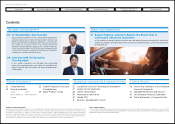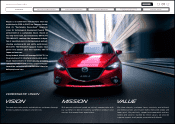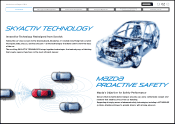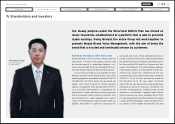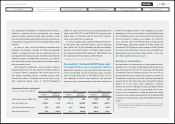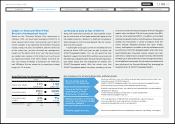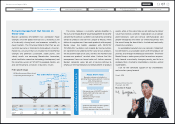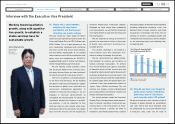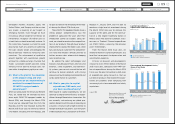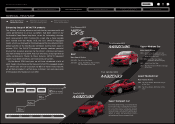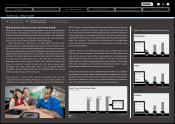Mazda 2014 Annual Report Download - page 10
Download and view the complete annual report
Please find page 10 of the 2014 Mazda annual report below. You can navigate through the pages in the report by either clicking on the pages listed below, or by using the keyword search tool below to find specific information within the annual report.
Interview with the Executive Vice President
Q1. Please tell us about Mazda’s
initiatives to raise future
profitability and the financial
structure you seek to achieve.
We have raised our initial target for March
2016 fiscal year operating income under the
Structural Reform Plan, to ¥230.0 billion from
¥150.0 billion. This is in part because of the
yen’s weakening compared with exchange
rate levels at the time of our initial forecast,
but also reflects expectations of: (1) curtailed
sales incentives and a shift to a right-price sales
policy from the introduction of SKYACTIV-
equipped models and (2) further cost improve-
ments through Monotsukuri Innovation.
We are making steady progress under
the Structural Reform Plan in these areas,
but going forward there are two challenges
for which we need to step up our efforts.
The first is to achieve sustainable growth.
As we have said previously, we are building
new plants in Mexico and Thailand to support
the increase of global sales, and these are
successively commencing operations. In
addition to releasing new products, we are
engaged in full-scale advertisement to
strengthen the Mazda brand. To offset this
investment burden and increase in market-
ing expenses, it will be important to fully
meet our plan for sales volume while main-
taining our right-price sales policy on a global
basis. In terms of costs, we will expand and
reinforce Monotsukuri Innovation globally.
Although we have always been promoting
cost improvement, we will further accelerate
cost improvement on and after the release of
the new Mazda2.
We will expand our lineup of SKYACTIV
products to maximize its effect in the areas
of brand, sales, and costs, to achieve sus-
tainable growth.
The second challenge is to establish a
solid financial base with enhanced resil-
ience to foreign exchange fluctuations.
We are restructuring our global produc-
tion footprint to increase our resilience to
foreign exchange fluctuations. To achieve
this, we will maintain our capacity utilization
at domestic plants at their current level and
respond to volume growth going forward with
increased production at overseas plants. We
will also move forward with the establishment
of a global supply chain for optimal parts pro-
curement in our main production regions of
Japan, China, ASEAN, and Mexico. This will
increase our foreign currency-denominated
parts procurement and enhance resilience to
foreign exchange fluctuations.
Our steady progress under the Structural
Reform Plan is bringing about major improve-
ments in Mazda’s earnings structure, but our
financial base is still in the process of recov-
ery. Going forward, I believe we need to
establish a solid financial base that is able to
withstand changes in the external environment,
including unforeseen economic crises, the
demand trend in major markets, and sharp
fluctuations in exchange rate levels. We are
working to achieve sustainable growth and
strengthen our financial base with an empha-
sis on increasing equity and reducing inter-
est-bearing debt.
Q2. Why did you lower your target for
global sales volume in the March
2016 fiscal year to 1.52 million
units from the initial 1.70 million?
We have revised our sales volume in light of
changes in global demand for automobiles
and sales trends that have emerged since
we announced our Structural Reform track
in February 2012. Sales are on track in
Working toward qualitative
growth, along with quantita-
tive growth, to establish a
stable earnings base for
sustainable growth.
Akira Marumoto
Representative
Director and
Executive
Vice President
375.8 370.2
263.0
300.8 274.1
74.0 86.3
64.2 55.2
39.8
Net Interest-bearing Debt /
Net Debt-to-equity Ratio
Billions of yen / %
2010 2011 2012 2013 2014
Net Interest-bearing Debt
Net Debt-to-equity Ratio
(As of March 31)
08
Mazda Annual Report 2014
CONTENTS
Message from Management
Introduction
Brand Value Management
Review of Operations
Foundations Underpinning
Sustainable Growth
Financial Section


